What is the Atomizer in a Vape?
A vape atomizer is part of the device that turns the e-liquid into vapour. It comprises of the wick and coil, which can be crucial parts in a vape.
If you’ve only recently switched from smoking to vaping and are wondering what a vape atomizer is and how it works - read on. This guide explores all the essentials on this topic.
How Does a Vape Atomizer Work?
Atomizers work by heating e-liquid and turning it to vapour. The majority of atomizers connect to a tank, which holds the e-liquid. From here, the liquid is drawn onto the coil by the wick (this is the fabric part of the vape that becomes saturated with e-liquid). The e-liquid is then heated by the coil which turns it into a vapour.
A vape atomizer is made up of different components. The coil (often called the atomizer head) and wick are responsible for drawing in and heating up the e-liquid, subsequently turning this into the vapour adult users consume. Discover more on the parts a vape atomizer could contain in the visual below.

Vape Atomizer Types
There are several types of technology used in vape atomizers, some of which are more complex than others, and the atomizer you choose can change the vaping experience.
Different vape atomizers might allow for different airflows, which will impact the density of the vapour. Some atomizers require specific types of e-liquid, vaping devices, and other variables. Explore these different types of vape atomizers below.
MTL Atomizers
Mouth to Lung (MTL) vaping means the vapour is drawn into the mouth and then inhaled. This method is comparable to the process of smoking a cigarette. Vape atomizers designed for MTL-style vaping have specific features, including smaller chimneys and coils that are designed for restricted vapour flow.
These devices often use e-liquids with higher concentrations of propylene glycol (PG) to vegetable glycerine (VG), delivering a strong “throat hit” – the sensation felt at the back of the throat upon inhalation.
Sub-Ohm Atomizers/DLT Vape Atomizers
Sub-Ohm devices/DTL vape atomizers use a high airflow and low resistance coils; this means more current is flowing through the circuit which results in hotter coils and more vapour production. Ohm’s law is used to determine the current, voltage and resistance in circuits; sub-ohm simply means the total resistance in the circuit is less than 1ohm.
Because these atomizers use more power to create higher temperatures and denser vapour clouds, a higher VG concentration is recommended. Greater airflow allows for DTL (Direct To Lung) vaping, where the vapour is drawn directly to the lungs without being held in the mouth first.
Learn more about MTL and DTL vaping styles.
RBA Atomizers
Rebuildable Drip Atomizers (RDA) and Rebuildable Tank Atomizers (RTA) are both types of Rebuildable Atomizers (RBA), meaning both can be rebuilt. This allows for core components of the atomizer head to be changed without having to replace the whole unit.
Many experienced vapers prefer RTAs/RDAs for this reason, particularly since adult users can change and customise coils on these types of devices using a variety of techniques.
The difference between RDAs and RTAs is in the reservoir, the holder of the e-liquid. RDAs require users to place a few drops of e-liquid directly onto the coils — this means the device does not have a tank to carry e-liquid and users must carry e-liquids separately to refill their device. Some users enjoy this as it allows them to easily switch from flavour to flavour.
Furthermore, because the e-liquid is dripped directly onto the wick right before it is turned to vapour, RDAs may deliver more flavour and large amounts of vapour. RTA vapes, on the other hand, have a tank reservoir which holds more e-liquid within the device itself. The filling mechanism in RTAs is similar to standard clearomizers.
Rebuildable atomizers should only be used by experienced vapers with a solid understanding of vaping technology and ohm’s law.
Vape Terminology
You may also see vape atomizers referred to as clearomizers, cartomizers, or sometimes as tanks. Whilst there are subtle differences between these atomizer types, they all fall under the ‘atomizer’ category. For further clarity, we’ve defined all three below.
Atomizers
Vape atomizer refers to the wick and coil within a vape device. The wick (typically made of cotton) draws in e-liquid from the tank and onto the coil - the element that heats the e-liquid to produce a vapour.
Cartomizer
Cartomizers combine the atomizer (the coil and wick) with the cartridge/tank. Unlike most mods and rebuildable vapes, which house e-liquid in a separate tank, these devices surround the vape atomizer with e-liquid by housing the coil and wick within the cartridge – these combined elements are then connected directly to a battery. By combining the two components, cartomizers are more compact than other vapes and some of them are referred to as cigalikes due to their slim, cigarette-like design.
Clearomizer
Clearomizers, like cartomizers, combine the coil, wick and e-liquid within a single component. The main point of difference with clearomizers comes in their appearance; as the name suggests, they use a clear tank which allows users to monitor the e-liquid level in the device.
Cleaning Atomizers - How to Clean Your Atomizer
How you go about cleaning atomizers will depend on the type you use. For the average vaper using a replaceable type of atomizer, you might be able to clean this component using the following method:
1.Carefully remove the atomizer from the vape.
2.Separate the mouthpiece and tank from the atomizer head.
3.Rinse the tank and mouthpiece under warm, running water before leaving the parts to air dry.
4.Soak the atomizer head in vinegar for a few hours.
5.Rinse the atomizer head out thoroughly with water.
6.Leave it to air dry.
All this said, cleaning atomizer heads might not be the best move forward. If the coil on your replaceable vape atomizer becomes burnt, it’s typically advised to just switch this out with a new one. Where possible refer to the instructions of your specific product or the shop/website you bought the products from for specific advice.
If you’re cleaning atomizers on a rebuildable device (i.e., RDAs or RTAs), you might be able to remove the wick, wash the coil under running water and let it dry before installing the atomizer head with a fresh wick.
Find out more on cleaning atomizers and other vape parts in our article - How to Clean Your Vape.
What is the Difference Between a Coil and an Atomizer?
The coil is the heating element found inside an atomizer. Simply put, an atomizer cannot work without a coil, but a coil is just one part of an atomizer. A coil may be called an ‘atomizer head’.
The coil, in the most basic sense, is a metal piece which heats up to vapourise the e-liquid. Coils might need to be replaced every few weeks - this is not only because of the metal filament itself being affected by wear and tear, but the wick also wears down. While the wick is separate from the coil, it is fundamental to the coil functioning properly.
RDA and RTA atomizers can be taken apart to replace only the wick or coil, while other vape devices may require the entire atomizer to be replaced.
How Do You Know When a Coil Needs Replacing in a Vape?
There are a few general signs that a coil needs replacing. These include the following:
•Burnt taste - you may start to notice a burnt taste when using your vape.
•A brown build-up - burnt coils can also show on atomizer heads as a gunky build-up of browned e-liquid. You might be able to spot this around the gaps of the vape atomizer.
•Leakage - if the coil is burnt, it might lose its ability to hold e-liquid, which could cause leaks.
Almost all coils will have a finite lifespan, so it’s useful to check your atomizer for signs of coil degradation, and equip yourself with the knowledge of how to fix a burnt coil.
Why Does My Vape Say No Atomizer?
If you get the “No Atomizer” message on your vape, it usually suggests that the device doesn’t have an atomizer in it. Either that or the device doesn’t recognise the atomizer you’ve placed in it.
Find out more on how to fix “no atomizer” on vape devices, as well as other errors like “Atomizer Short” and “Check Atomizer” vape signals.
How to Make Your Vape Atomizer Last
You could extend the life of your vape atomizer with the following general maintenance tips:
•Prime your coils properly - some coils may require proper priming to avoid burning out prematurely.
•Keep your tank topped up with e-liquid - insufficient e-liquid in the tank can cause the coil to burn.
With a thorough understanding of vape atomizers, you can help to preserve your vaping experience. However, there are some vapes that don’t require any atomizer maintenance or knowledge, including the devices in our VEEV range. Learn more at Discover Vaping.
Smoke-free products are not risk-free and provide nicotine, which is addictive. The best decision any adult smoker can make is to quit tobacco and nicotine use altogether. Smoke-free products are not alternatives to quitting and are not designed as cessation aids.
This article is for general information and educational purposes. Some of the information in this article is based on external, third-party sources and we make no representations or warranties of any kind regarding the accuracy, validity or completeness of such information.














